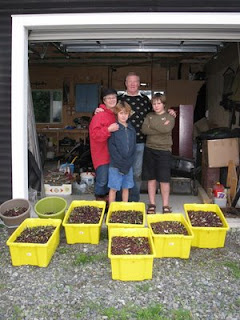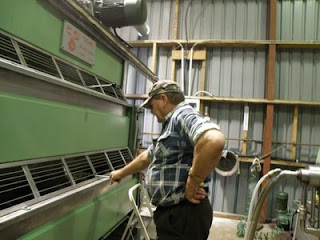 More than 30 Wairarapa olive growers gathered in the warm sun at Kate and Mark Bunny's property at Loopline. Arranged by Andrew Priddle in the field day series for ONZ Wairarapa, this pruning session build on the two Andrew did last year in the Akrotiri Grove.
More than 30 Wairarapa olive growers gathered in the warm sun at Kate and Mark Bunny's property at Loopline. Arranged by Andrew Priddle in the field day series for ONZ Wairarapa, this pruning session build on the two Andrew did last year in the Akrotiri Grove.Taking several branches laden with ripe black olives, Andrew dramatically placed these on the ground; Koroneki, Barnea and Manzanilla. The trees around us were bereft of olives, with the Wairarapa harvest having been in early July. Where were these from? How come these branches still have olives. Its harvest time in the Hawkes Bay responded Andrew! This response underpined the keys of our session on pruning.
Prune for local conditions. Local being New Zealand rather than italian or spanish conditions. In New Zealand we have younger trees, better soils and therefore greater flower to fruit ratios. So pruning to enable the tree to hold these large amounts of fruit was essential.

Andrew took some time to teach us olive physiology as it relates to pruning. Prune to let the sun in and to stimulate growth of new branches in areas weak in canopy. In this grove Andrew was pruning to stimulate canopy growth and a tree structure to hold more fruit two seasons into the future. Right: Andrew deciding which is the central leader and which is the competition.
andrew worked with several principals: 3 large cuts per tree, 30% of the current canopy is taken. These cuts allow the sun into the inner part of the tree, and enable air circulation. Crucial in humid times after rain, when virus and fungi are in the air, wind circulation lessens the chances of these taking hold. Other pruning cuts are smalle
 r and for tree hygeine (low branches remaining in the shade, and are likely to attract disease) or cutting low hanging branches for ease of grove management, e.g. mowing.
r and for tree hygeine (low branches remaining in the shade, and are likely to attract disease) or cutting low hanging branches for ease of grove management, e.g. mowing.The inner structure of the remaining tree enables air circulation and diminishes fungal and other diseases. Dismissive of the 'bird can fly through the olive tree', Andrew proposed being able to identify who is on the other side of the tree was a more workable measure of density.
Using the branches he had had bought, Andrew showed how us to assess the internode length (the space between the leaves). Where the leaf meets the stem, the flower catkins emerge. Each catkin might have 8 flowers. In many countries, the ratio of flowers to fruit set is 2 - 3%. Andrew showed us the flower to fruit ratio on the branches he had bought. These were closer to 40%.
He indicated the short internode distance meant that the tree was stressed either by lack of water, disease or just too much fruit. This meant the stressed tree would
 not produce so much fruit in subsequent years which has implications for pruning and grove management.
not produce so much fruit in subsequent years which has implications for pruning and grove management.I was fascinated by the manzanilla branch with lush black olives. I squeezed one, the inner fruit was moist and dark red. Bitter to taste but not too bitter. I was amazed the birds hadn't stolen these fruit and loved seeing the abundance on the branches. Right: The three cuts opening the tree to the north, to stimulate new growth and canopy mass.
Andrew linked several themes in his presentation to last years session in determining the number of olives per kilo, (1120 for koroneki, 240 for manzanilla), assessing the cost of harvesting trees when there is only a few kilos of fruit ($5 per tree and 10kg fruit means 50c kilo in getting fruit to the press, obviously less where there is more kilos of fruit per tree.
Andrew set to work. Begining on the north facing side of the tree ( where the wind and sun comes from in Wairarapa), he assessed little canopy or future canopy with the current tree structure. Thinking the trees would be harvested by shaker in the following season he looked for a central leader branch and a more open inner structure of the tree. Each cut was made to stimulate growth. He encouraged us to leave the 5 - 8 shoots which will grow in response to the cut. If these shoots are trimmed too ear
 ly, the desirable shoots grow inwards and this renders them useless as structural branches later on.
ly, the desirable shoots grow inwards and this renders them useless as structural branches later on.To stimulate branches growing to the north, Andrew used his chainsaw to make cuts in the north facing trunks around hip height. These were painted immediately with Bacseal as were all the cuts he made. Spring pruning means moisture or disease can easily enter the cuts so sealing these immediately is essential.
Andrew identified January as the time of year to remove water shoots from the base of the tree. A dry January that is, so again no water carrying disease can enter the site where the shoots have been removed.
Over the next hour, Andrew pruned four trees; all different varieties and stages of development. The same principles were used with each tree. The session drew to a close at 4pm and we moved off to taste five different oils in the late afternoon sun.
The first oil was from Loopline and was a blend, then two from Leafy Ridge, the fourth from Odell's Stone Valley and the fifth from Julie's Greytown gold. We smelled the aromas and did our best to identify the aroma's; herbs, fruit and vegetable noses of the oil, then tasted. We tasted for harmony and balance, and for flavours. We noticed the kick or peppery bite distinctive of some oils. The colours of the oils we tasted ranged from deep greens of the newly pressed oils to bright yellow of the one year old oils. We discussed storeage of oils, pressing times, and blends. A great afternoon of learning, discussions and getting to know one another as growers and producers in the Wairarapa region.












































